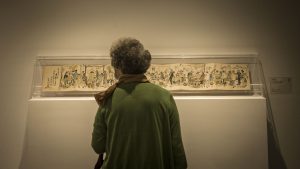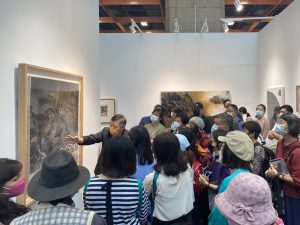By SHOINMACHI5
Editor's Note: This article serves as a continuation of "Media or Tradition: Starting from Recent Curatorial and Discourse on "The End of Ink Painting" (Part I)," and further explores the notion that ink painting is marginalized by Taiwan-centric cultural policies due to its roots in Chinese culture.
Continuing from Part 1 of this article, Shih Shou-Chien contends that public art museums marginalize ink painting due to its "close ties with Chinese culture," a consequence of the influence of "Taiwan-centric cultural policies." In fact, similar viewpoints were raised by participating scholars at "The First Eastern Painting Biennial 2023" hosted by KAI'S Gallery this past July. Do these claims hold true? ? Or is this merely an illusion stemming from a conflation of the ink medium with brushwork traditions and Chinese cultural ideology?
Taiwanese Subjectivity and Ink Painting?

In the exhibition " The Everlasting Bloom: Rediscovering Taiwanese Modern Art "
, the public carefully observes Ran In-Ting 's "Yongle Market(Market Scenes)". (Photo courtesy of MoNTUE)
Let's discuss the exhibitions under the Ministry of Culture's initiative to "Reconstruction of Taiwan's Art History," including the 2021 "Centenary of Taiwan Cultural Association". The funding of Forward-Looking Infrastructure for this "Reconstruction of Taiwan's Art History" has certainly accumulated new exhibitions and scholarly discourses for Taiwanese art history that has previously been neglected or stagnant. However, it sometimes also attracts criticism for being overly ideological, thereby detaching from the context of the artworks. Despite this, the process of reconstructing Taiwan's art history has still accomplished the acquisition and restoration of numerous ink paintings. For example, the early ink works and drafts by Lin Yu-Shan (1907-2004), or the restoration of the "Formosa Evergreen Scroll," demonstrate that ink painting remains an integral component of Taiwan's art history.
In terms of exhibitions, based on my preliminary observations, it is more accurate to say that the number of exhibitions themed on media has declined significantly, rather than to say that the number of ink painting exhibitions has decreased. In recent major exhibitions related to Taiwan's art history, such as "Revisiting the Classics: Special Exhibition of Existing Works of Taiten and Futenn," " The Everlasting Bloom: rediscovering Taiwanese modern art," or "LUMIÈRE-The Enlightenment and Self-Awakening of Taiwanese Culture," ink painting is not absent. Rather, it is incorporated within these frameworks that are primarily historical or art historical in nature.
Among these, "Revisiting the Classics" exhibits the surviving works of the Taiwan Provincial Art Exhibition during the Japanese ruling period. "Solitude" by Kuo Hsueh-Hu (1908-2012), which was an important exhibit in the Toyoga Section, is a masterpiece of ink painting that has not been marginalized by the "Taiwan-centric cultural policies". According to research, Kuo Hsueh-Hu first crumpled the paper before applying ink, resulting in complex textures and variations in ink traces. It can be said that it is a creation that further innovates on the basis of the brushwork tradition.

Kuo Hsueh-Hu, “Solitude”, 1933, ink on paper, Collection of National Taiwan Museum of Fine Arts.
Ink painting has been a significant creative medium in Taiwan's art history since the Qing Dynasty, and the brushwork tradition associated with this medium also faces challenges and pressures for transformation in this changing time. This discourse is also present in publicly-curated exhibitions that emphasize Taiwanese subjectivity. Of course, this does not mean that the concerns of scholars worrying about the marginalization of ink painting are unfounded. Rather, their focus is more on issues related to the tradition of Chinese painting and calligraphy, rather than the discourse on ink painting under the context of Taiwanese subjectivity.
ART TAIPEI and Ink Painting
If the ink painting display strategies in exhibitions related to the "Reconstruction of Taiwan's Art History" more or less resonate with the government's emphasis on Taiwanese subjectivity in policy discourse, then including ART TAIPEI, private galleries, and institutions that discuss ink painting subtly reflect and echo government narratives. At the same time, they demonstrate the possibility of a market-oriented approach while concurrently presenting alternative discursive viewpoints.
Some scholars have observed the limited exhibit ink painting at ART TAIPEI. However, based on my exhibition experiences in recent years, artworks utilizing ink as a medium continue to represent a substantial portion of the displays, and there are even lectures dedicated to this theme. Nonetheless, the perception that their exhibit is relatively limited is not entirely unfounded. This consideration takes into account the participation and curatorial strategies of international galleries, as well as the ever-evolving nature of artistic mediums. This echoes my earlier point that ink painting is shedding the burden of past nationalism and returning to its nature as a medium.
-300x136.jpg)
Book and painting vendors depicted in the Qing court version of "Up the River During Qingming" (photo courtesy of National Palace Museum)
In my opinion, from the perspective of art history, "ink painting," like many other mediums, can be described as an Ouroboros of creative and market orientations. Artists rely on the market for their livelihood, which in turn fuels new directions in production that are subsequently reintroduced into the market, thus forming a continuing cycle.
As early as the Qing Dynasty in China, the genre painting, the Qing court version of "Up the River During Qingming," which reflected the urban economy of the time, depicted commercially oriented, blue-green colored landscape scrolls for sale on city streets. These market-driven works often originated from classic motifs created by artists, and even various imitations of "Up the River During Qingming" were popular urban commodities of the time. Evidently, the market has always been a pivotal node in both the creation and reproduction process of ink-based works. Today, the market plays an even more direct and potent role in the production of discourse. This is exemplified in recent years by ART TAIPEI and certain galleries, who actively collaborate with academic institutions to host lectures or curate exhibitions.

A view of Xi Zhi Tang Galley in ART TAIPEI 2022 (photo courtesy of Xi Zhi Tang Galley )
Conclusion
Given the sustained high level of attention that ink painting receives in the commercial market, it is evident that numerous artists continue to explore the various possibilities of this medium, even expanding its dimensions. Some scholars question whether these expansions still qualify as ink painting. This is a recurring debate, especially in an era teeming with diverse media and market stimuli, where the boundaries of ink art are bound to blur to some extent. To reiterate, the medium is neutral. The process of applying varying intensities of ink on Xuan paper (rice paper) need not necessarily respond to any specific tradition.
Will ink painting vanish? Will it become an "Intangible cultural heritage?" From the perspective of the art world, and even in a consumption space like ART TAIPEI, the prospects for ink painting remain promising. As for the culture of brushwork that the medium carries, I am more optimistic about it. Tradition itself undergoes constant transformation, evolving into the next phase of its evolution. Such cycles of upheaval and rejuvenation are historical phenomena that have occurred repeatedly throughout East Asian art history.
